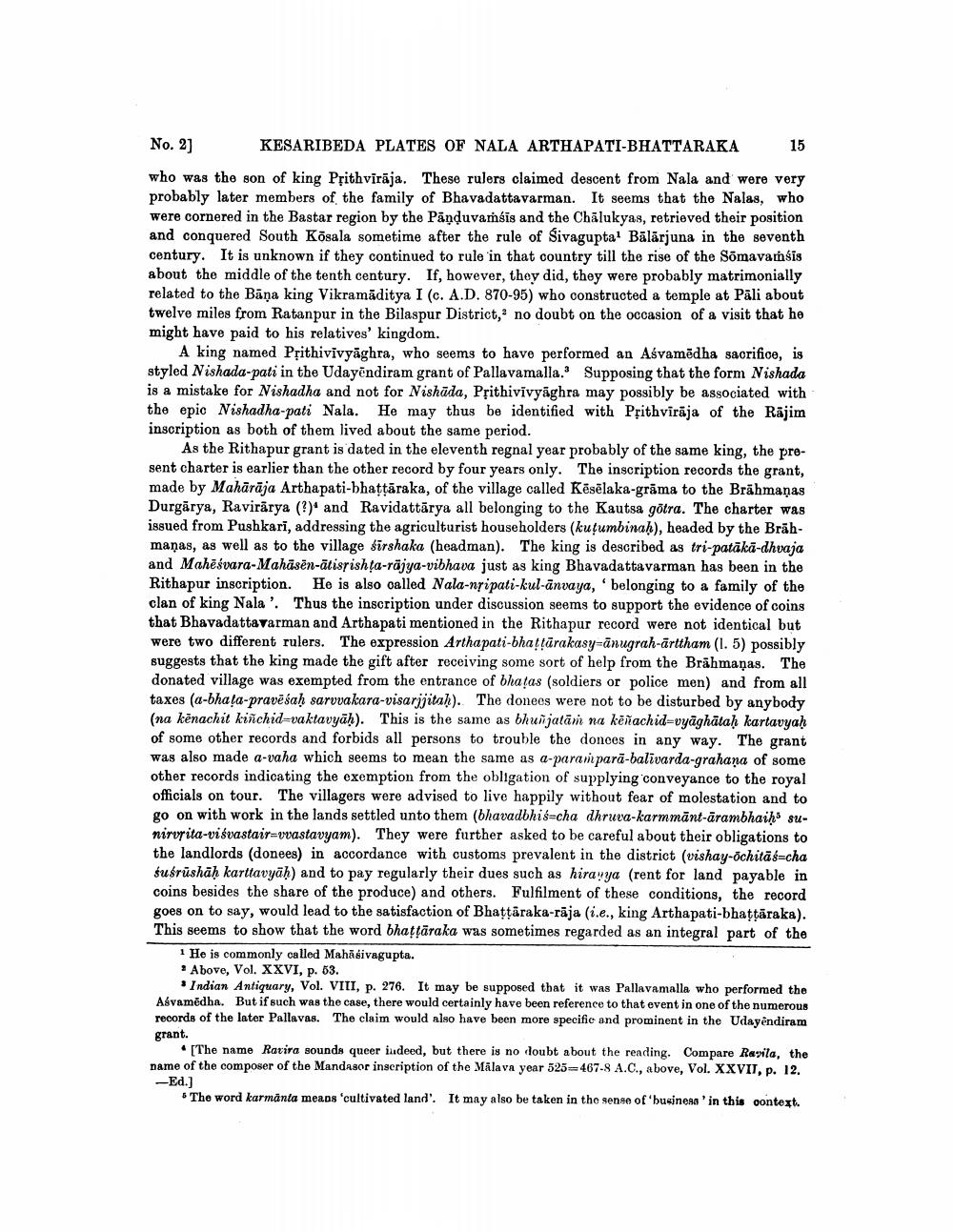________________
No. 2] KESARIBEDA PLATES OF NALA ARTHAPATI-BHATTARAKA 15 who was the son of king Prithviraja. These rulers claimed descent from Nala and were very probably later members of the family of Bhavadattavarman. It seems that the Nalas, who were cornered in the Bastar region by the Pânduvařáis and the Chālukyas, retrieved their position and conquered South Kösala sometime after the rule of Sivagupta Bālārjuna in the seventh century. It is unknown if they continued to rule in that country till the rise of the Sömavam is about the middle of the tenth century. If, however, they did, they were probably matrimonially related to the Bāņa king Vikramāditya I (c. A.D. 870-95) who constructed a temple at Pāli about twelve miles from Ratanpur in the Bilaspur District, no doubt on the occasion of a visit that he might have paid to his relatives' kingdom.
A king named Prithivivyāghra, who seems to have performed an Aśvamēdha sacrifice, is styled Nishada-pati in the Udayēndiram grant of Pallavamalla. Supposing that the form Nishada is a mistake for Nishadha and not for Nishāda, Prithivivyāghra may possibly be associated with the epic Nishadha-pati Nala. He may thus be identified with Přithvirāja of the Räjim inscription as both of them lived about the same period.
As the Rithapur grant is dated in the eleventh regnal year probably of the same king, the present charter is earlier than the other record by four years only. The inscription records the grant, made by Mahārāja Arthapati-bhattāraka, of the village called Kēsēlaka-grāma to the Brähmaņas Durgārya, Ravirărya (?)' and Ravidattārya all belonging to the Kautsa götra. The charter was issued from Pushkari, addressing the agriculturist householders (kuļumbinah), headed by the Brāhmanas, as well as to the village sirshaka (headman). The king is described as tri-patākā-dhvaja and Mahēšvara-Mahāsēn-ātissishta-rajya-vibhava just as king Bhavadattavarman has been in the Rithapur inscription. Ho is also oalled Nala-nsipati-kul-anvaya, 'belonging to a family of the clan of king Nala'. Thus the inscription under discussion seems to support the evidence of coins that Bhavadattavarman and Arthapati mentioned in the Rithapur record were not identical but were two different rulers. The expression Arthapati-bhattārakasy-anugrah-arttham (1.5) possibly suggests that the king made the gift after receiving some sort of help from the Brāhmaṇas. The donated village was exempted from the entrance of bhatas (soldiers or police men) and from all taxes (a-bhala-pravēšah sarvvakara-visarijitah). The donees were not to be disturbed by anybody (na kēnachit kinchid-vaktavyāḥ). This is the same as bhuñjatām na kēñachid=vyāghātaḥ kartavyah of some other records and forbids all persons to trouble the donces in any way. The grant was also made a-vaha which seems to mean the same as a-paran para-balivarda-grahana of some other records indicating the exemption from the obligation of supplying conveyance to the royal officials on tour. The villagers were advised to live happily without fear of molestation and to go on with work in the lands settled unto them (bhavadbhis-cha dhruva-karmmānt-ārambhaih sunirurita-visvastair=vvastavyam). They were further asked to be careful about their obligations to the landlords (donees) in accordance with customs prevalent in the district (vishay-ochitās cha susrüshāh karttavyāḥ) and to pay regularly their dues such as hirayya (rent for land payable in coins besides the share of the produce) and others. Fulfilment of these conditions, the record goes on to say, would lead to the satisfaction of Bhattāraka-rāja (i.e., king Arthapati-bhattāraka). This seems to show that the word bhatļāraka was sometimes regarded as an integral part of the
1 He is commonly called Mahasivagupta. : Above, Vol. XXVI, p. 53.
Indian Antiquary, Vol. VIII, p. 276. It may be supposed that it was Pallavamalla who performed the Asvamëdha. But if such was the case, there would certainly have been reference to that event in one of the numerous records of the later Pallavas. The claim would also have been more specific and prominent in the Udayêndiram grant.
• [The name Rarira sounds queer indeed, but there is no doubt about the reading. Compare Ranila, the Dame of the composer of the Mandasor inscription of the Mālava year 525=467-8 A.C., above, Vol. XXVII, p. 12. -Ed.)
The word karmanta means 'cultivated land'. It may also be taken in the sense of 'business' in this context.




